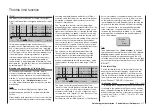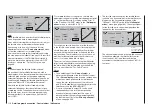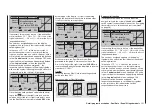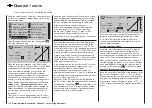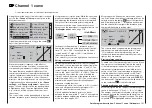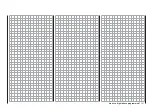
128
Detail program description - Channel 1 curve | Winged models
Channel 1 curve
Control characteristics for throttle/spoiler joystick
Using the selection keys of the left or right touch pad,
scroll to the »
Channel 1 curve
« menu option in the
Multi-function menu:
Model select
Ser vo adjustmen
t
Stick mode
Control adjust
Dual Rate / Expo
Channel 1 cur ve
Switch display
Copy / Erase
Suppress codes
Suppress models
Base setup mode
l
Model type
Open this menu option with a tap on the center
SET
key of the right touch pad.
Channel 1 C U R V E
Curve
off
Point
Output
Input
0%
0%
?
+
–
100
¼
O U
T P U
T
0%
Since the carburetor response or the effect of the
airbrakes or spoilers is often non-linear, you can make
compensatory adjustments to these in this menu.
The menu therefore enables you to change the
control characteristics of the throttle / airbrake
joystick
, regardless of whether this control function
affects the servo connected to control channel 1
directly or affects multiple servos via various mixers.
If fl ight phases have been specifi ed in the »
Phase
settings
« and »
Phase assignment
« menus (see
pages 142 and 148) this option can be adapted on
a fl ight-phase basis. The given fl ight phase name,
e.g. «normal», will be shown at the bottom left of
the screen.
The control curve can be defi ned by up to 8 points
(termed "reference points" below) placed anywhere
along the path of joystick travel. While the on-screen
graph considerably simplifi es the process of setting
and adjusting the reference points, we recommend
that you set fewer reference points to begin with.
In the basic software set-up, 2 reference
points – namely the end-points at the bottom end
of joystick travel ("L", low = -100 % travel) and
the top end of joystick travel ("H", high = +100 %
travel) – defi ne a linear characteristic curve.
First, switch to your chosen fl ight phase, if necessary.
Setting reference points
By moving the transmitter control (throttle/airbrake
joystick), you can reposition the vertical line in the
graph between the two end-points "L" and "H". The
current joystick position is also displayed in numerical
form on the "Input" line (-100 % to +100 %). The point
at which this line crosses the curve is termed the
"Output", and can be varied at the reference points
within the range -125 % to +125 %. The control signal
altered in this way will then affect all subsequent
mixer and coupling functions.
In the example above, the joystick is at 0 % of control
travel and also generates an output signal of 0 %,
since the characteristic curve is linear.
Up to 6 additional reference points can be set
between
the two end-points "L" and "H", although the
distance between neighboring reference points must
not be less than approx. 25 %.
Move the joystick. If a question mark can be seen in
the "Point" frame, then the next reference point can be
set with a tap on the center
SET
key of the right touch
pad. Simultaneously, the "?" is replaced by a number
and the value fi eld to the right of the reference point
number will be shown in inverse video.
Channel 1 C U R V E
Curve
off
Point
Output
Input
+50%
+50%
2
+
–
100
¼
O U
T P U
T
1
+50%
Normal
2
The order in which you generate the (maximum) 6
reference points between the end-points "L" and
"H" is irrelevant, since the reference points are
continuously renumbered automatically from left to
right as they are entered.
Erasing reference points
To delete one of the reference points (1 to max. 6),
use the joystick to move the vertical line into the
vicinity of the reference point in question. As soon
as the reference point number and its corresponding
value on the "Point" line are displayed in inverse
video, see fi gure above, these can be erased with a
simultaneous tap on the
cd
or
ef
keys of the right
touch pad (
CLEAR
). Complete the operation with a
brief tap on the center key
ESC
of the left touch pad.
Changing reference point values
Move the joystick into the range of the reference point
that is to be changed: "L" (low), 1 … 6 or "H" (high).
The number and current curve value of this point are
displayed. The reference point value displayed in
inverse video can be changed in a range of -125 % to
+125 % without infl uencing the neighboring reference
points.
Summary of Contents for 32032
Page 1: ...33020 mc 20HoTT 2 en Programming Manual o Pro Pro mc 20 mc 20...
Page 15: ...15 For your notes...
Page 21: ......
Page 27: ...27 For your notes...
Page 41: ...41 For your notes...
Page 53: ...53 For your notes...
Page 59: ...59 For your notes...
Page 63: ...63 For your notes...
Page 93: ...93 For your notes...
Page 97: ...97 For your notes...
Page 141: ...141 How is a ight phase programmed...
Page 145: ...145 For your notes...
Page 155: ...155 For your notes...
Page 175: ...175 For your notes...
Page 203: ...203 For your notes...
Page 219: ...219 For your notes...
Page 253: ...253 For your notes...
Page 283: ...283 For your notes...
Page 321: ...321 For your notes...
Page 322: ...322 For your notes...
Page 323: ...323 For your notes...




